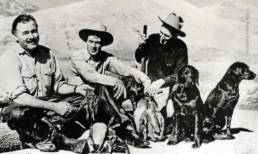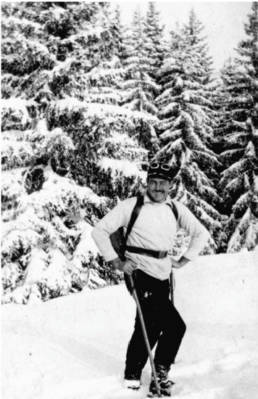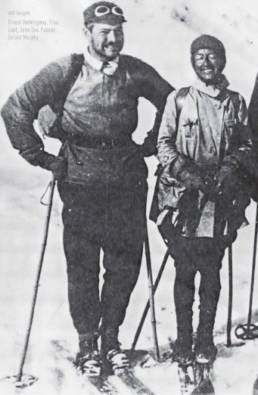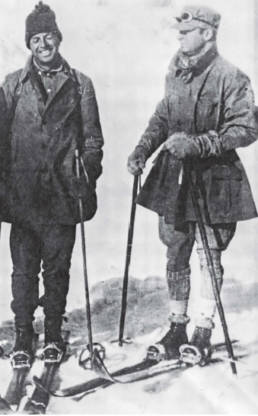He was reared in an Illinois suburb where the dreary flatness of the prairie was visible from his Oak Park home, so naturally, he was drawn to conquer the peaks
he saw while stationed in the Dolomites in World War I. Later he grew a black beard, “burned my face so badly on the high snow” that his complexion grew dark, became fond of the Austrian schnapps known as Kirsch, and as a result, was known in the ski villages of Europe as “the black Kirsch-drinking Chris.” ln the cities of Spain he was captivated by bullfights, in the velds of Africa by big-game hunting, in the mountains of the Alps by what he described, in a 1923 article for the Toronto Star newspaper, as the way “the earth came up and over and over” as he descended a Swiss piste.
He was Ernest Hemingway, author, adventurer, and skier.
“Finally towards spring there was the great glacier run, smooth and straight, forever straight if our legs could hold it, our ankles locked, we running so low, leaning into the speed, dropping forever and forever in the silent hiss of the crisp powder,” he wrote in A Moveable Feast. “It was better than any flying or anything else, and we built the ability to do it and to have it worth the long climbs carrying the heavy rucksacks.”
through the powder snow.” Boy, the man could write. Boy, the man could ski.
And when he wrote about skiing, as he did in the newspaper articles, short stories, and novels-whether he was speaking, in A Moveable Feast, about “that avalanche winter” or, in ln Our Time, of how “the gale scouring the exposed surface of the mountain had swept the snow surface into a wind-board crust” – he captured the exhilaration of our winter sport but he also
Hemingway was known for fishing in the deeps but also for going “as fast as you believe possible, then you go a good deal faster, then you give up all hope” all the time moving”down in a rushing, swooping, flying, plunging rush of fast ash blazes
displayed his special awareness of, and his unusual sensitivity to three of the five senses: sight, sound and touch. Plus love.
Much of his skiing was done with his first wife, and the two even skied when Hadley was pregnant with their child. Hemingway won the permission of her doctor to take her skiing only, as he reported, “if I would promise that she would not fall down.” With the primitive equipment available in 1922, and with the challenge of the runs at Cortina d’Ampezzo, one of the sites for the 1956 Winter Olympics and now part of the Dolomiti Superski area, that was no easy pledge to keep. “This took a very careful selection of terrain and runs and absolutely controlled running, but she had beautiful, wonderfully strong legs and fine control of her skis, and she did not fall.”
Nick, waxing his skis in the baggage car, pushed his hoots into the “toe irons” and shut the clamp tight. He jumped from the Car sideways onto the hard windboard, made a jump turn, and crouching and trailing his sticks slipped in a rush down the slope.
Of course, Hemingway would ski. He cultivated what Nancy W. Sindelar in her 2014 Jnf/uencingHemingwaywould describes as
“his fascination with the manifestations of physical endurance and courage.” It had all the Hemingway elements: it was a sport conducted outdoors, it involved risk, it required money, and at the end of the day, he was in a warm bed with a woman. The sport suited his rhythms, his outlook, and his abilities. “Hemingway was forever hurling himself at a natural landscape that offered a challenge,” said Hilary Justice, the Hemingway Scholar in Residence at the John F. Kennedy Library

and Museum, where Hemingway’s papers are housed. “You can’t fish in the wintertime and he didn’t own a boat yet. So he went skiing.” And though in some of his Michigan stories he would write about playing baseball in the Great Lakes resort towns of Petoskey and Charlevoix, Hemingway prized solitary pursuits that still had a modicum of companionship.
“He wasn’t much interested in team sports but there was something about an individual physical challenge in nature that allowed him to transcend whatever daily cares he had,” said Sandra Spanier, general editor of the Cambridge Edition of the Letters of Ernest Hemingway. “Skiing for someone from Illinois was exceedingly exotic. He tended to become very passionate about things and then experience them to the hilt. He did it with bobsledding, catching enormous marlin and of course skiing.”
And while he loved notoriety he also cultivated solitude. In the mid-1920s he spent several months in the Montafon valley in the westernmost Austrian state of Vorarlberg, where today the Silvretta resort offers 34 lifts and where protagonists in both his short stories “An Alpine Idyll” and “The Snows of Kilimanjaro” took to the slopes. There he
was, as Andreas Brugger, a legendary Swiss sportsman put it, “an unknown American [who] visited an unknown Austrian valley for skiing.”
And Hemingway loved equipment. In the fishing waters of Florida, he luxuriated in the complexities of Fin-Nor reels, studied how to rig baits, and knew the peculiarities of different types of tackle. In the mountains of Europe, he was a master of ski technique.
His story “Cross Country Snow,” collected in ln Our Time, is choked with technical descriptions of skiing,
demonstrating his dexterity both on the slopes and at the keyboard. “You’ve got to keep to your left,” he has one of his characters say, and then he employed a term that modern readers, unfamiliar with the stem Christiania that was a staple of early- and mid-20th century skiing until shaped skis made that elegant ski turn unnecessary, will find befuddling. “It’s a good fast drop with a Christy at the bottom on account of a fence.”
Hemingway also put an early, ruddy face to backcountry skiing.
“At a time when backcountry skiingskiing without the benefit of ski lifts is so popular, it’s interesting to recall that Hemingway got there first,” said Jeffrey Leich, the ski historian who is executive director of the New England Ski Museum. “He enjoyed skiing the Austrian backcountry before most Americans gave a thought to skis and skiing anywhere.”
“It’s good)d fast drop with a Christy at the bottom on. account of a fence.”
moment (after the tragedy of the 1914-1918 war that left Europe in ruins) and the man (who collected mad experiences and marvelous wives). “The skiing he did,” said E. John B. Al Jen, one of the leading ski historians in the country, “gave some measure of authenticity to his image of manliness.”
Verna Kale, a Hemingway expert who teaches American literature at Penn State University, added: “if you were an outdoors person and an adventurer, skiing the Alps in the ’20s was the kind of thing you wanted to do. You had to be strong enough in your limbs and lungs to get to the top and then strong enough to get down.”
They thrust bent-kneed along the road into a pine forest. The road became polished ice, stained orange and a tobacco yellow f om the teams hauling logs. The skiers kept to the stretch of snow along the side. The road dipped sharply to a stream and then ran straight uphill.
The world looks different from Hemingway’s time-the hills he traveled now are garlanded with all manner of ski conveyances, and the skis employed to ride them now have all manner of safety elements and are composed of materials such as fiberglass, carbon fibers, epoxy, and Polyethylene, all unknown in his time-but the world looks differently at Hemingway today. His treatment of women, his disregard for friendships, and his celebration of violence are all out of sync with contemporary values. Last year, PBS aired a three-part series produced by filmmakers Ken Burns and Lynn Novick that looked anew at Hemingway.

And they found that skiing remained a vital element of the author’s life and outlook.
While she was working on the film, Novick and her son took a chairlift from school in the Tyrol as far as it extended, put on climbing skins, and ventured into higher altitudes, traversing repeatedly between Austria and Switzerland. “I thought a lot about Hemingway when I was skiing there and we had an experience much like his,” she said.” He loved how exhilarating it was to be out all day climbing and then skiing down. It was the kind of physical challenge and being on the edge that really moved him. I kept thinking about how, in the 1920s, he was doing something that others who grew up in the Midwest, where there were no mountains like that, we’re doing.”
lt was on an Austria ski adventure that Hemingway learned that his first book, In Our
Time had been accepted for publication, and it was there that he polished The Sun Also Rises. The Hemingway Letters project at Penn State includes correspondence with Jane Heap, one of the editors of the modernist magazine Little Review, about Hemingway’s frostbite from having “nearly froze to death in a blizzard where l can least afford to freeze” and a letter he wrote while working on A
r Farewell to Arms, to Bark lie McKee Henry, a fiend with roots in the Vanderbilt fortune, musing that if he weren’t a writer he might “sail a boat for somebody or teach skiing-may yet.”
Crouching so he was almost sitting back on his skis, trying to keep the center of the grave(y low, the snow driving like a sandstorm, he knew the pace was too much. But he held it. The title would not let go and spill. Then a patch
of soft snow, lea in a hollow by the wind spilled him and he went over and over in a clashing of skis, feeling like :1 shot rabbit, – then stuck, his legs crossed, his skis sticking straight up and his nose and cars jammed full of snow.

Hemingway was an acolyte of the pioneer Austrian skier Walther Lent, himself an associate of Hannes Schneider, who brought Arlberg skiing to the United States when he fled Hitler and decamped in North Conway, N.H. Like Schneider, Lent believed that the way to learn to ski was simply to ski and (music to Hemingway’s ears!) to push yourself, not so much down the hill but to the uplands, where the skiing was more difficult but the rewards more substantial. “We became great students of avalanches, the different types of avalanches, how to avoid them and how to behave if you were caught in one,” he wrote in A Moveable Feast.
He also grew to love glacier skiing. In February 1925 he wrote to his friend Bill Smith a letter now in the Penn State archive: “A male running straight damn near attains the speed of a falling body the 1st 400 yards or so then the wind resistance piles up and holds him down to about 65-80 an hr. I’ve spilled at that-and you don’t know what it’s about for some time. Snow cushions wonderfully tho.” So did the fortune that Hadley possessed and that underwrote much of Hemingway’s ski adventures.

“He portrays himself as pretty poor in A Moveable Feast, but Hadley had a trust fund and they could afford to go skiing,” said Carl Eby, the Appalachian State University English professor who is president of the Ernest Hemingway Foundation and Society. “They’d go up and ski for a couple of days and go sledding. He loved that sort of thing.”
But in time his love for Hadley faded, as it did repeatedly with his wives, and in truth his first wife, and a doomed ski trip, played an important but heartbreaking role in Hemingway’s early writer’s life. Hadley planned to join her husband in the mountains and, while packing, gathered all his manuscripts from a dining-room cupboard and loaded them in a small suitcase. The result is what Gioia Diliberto, in her account in her 1992 Paris Without End, describes as “one of the most famous calamities of modern American literature.”
That is because the valise with the manuscripts disappeared while Hadleywandered about the Gare de Lyon before the Paris-Lausanne Express began its journey.
In time Hemingway found other diversions. He had a short attention span, for wives as well as for sporting hobbies, and besides, hearty as he was, he was not always hale, and age and alcohol took their toll. With Pulitzer and Nobel prizes in hand, he moved to Ketchum, Idaho, as the new decade of the 1960s, with all its promise and its New Frontier rhetoric, dawned.
“He enjoyed Sun Valley for the hunting opportunities but sadly never skied here,” said Nicole Potter, the regional history librarian at the Sun Valley Ski Museum. His final wife, Mary Welsh, skied, and so did his son Jack but, according to Mary Tyson, the director of the Center for Regional History in Ketchum, “he may have taken a lift ride or done some snow-shoeing, but he had lost interest in skiing by the time he was here.”
But America never lost interest in Hemingway, nor has his ski writing ever lost its piquant appeal.
“Will you ever go skiing together in the States?” George said. “I don’t know,” said Nick. “The mountains aren’t much,” George said. “No,” said Nick. “They’re too rocky. There’s too much timber and they’re too far away”
That exchange occurred in a story first published in Ford Mad ox Ford’s literary magazine Transatlantic Reviewing Paris in 1924. It captures Hemingway at his essence, for whether writer or skier, Ernest Hemingway never was interested in mountains that “aren’t much.”
Related Posts
May 10, 2011
SNOW Ski Wear and Apres Ski Editorial Fashion Shoot
Get behind the scenes as SNOW magazine…




